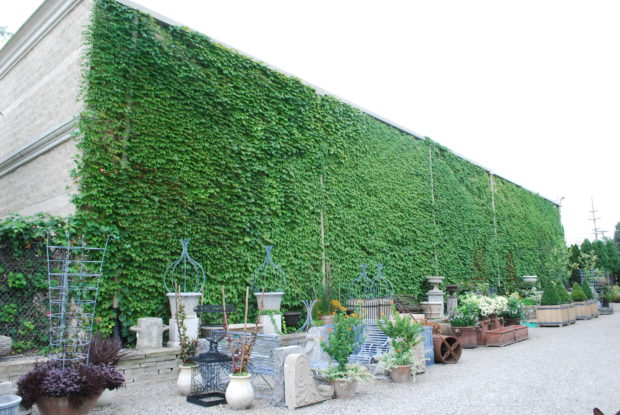 I have been writing about the Boston ivy growing on the walls of the buildings surrounding us for a number of years. A storage business put up buildings all around Detroit Garden Works many years ago. Some of those buildings proved to be on our property after an as-built survey. We settled the problem amicably. They ceded 6 feet of their property opposite the front door of our building, as pictured above, in return for our tolerance of their encroachment on our property in the back. That giant cream colored concrete wall was visually intrusive on our space, and oppressively tall. We opted for a landscape solution. Of course! 10 Boston ivy in 2 gallon pots were planted in regular intervals all along that wall close to 20 years ago. It took the better part of 15 years for that ivy to cover that wall. Cover that wall, it has.
I have been writing about the Boston ivy growing on the walls of the buildings surrounding us for a number of years. A storage business put up buildings all around Detroit Garden Works many years ago. Some of those buildings proved to be on our property after an as-built survey. We settled the problem amicably. They ceded 6 feet of their property opposite the front door of our building, as pictured above, in return for our tolerance of their encroachment on our property in the back. That giant cream colored concrete wall was visually intrusive on our space, and oppressively tall. We opted for a landscape solution. Of course! 10 Boston ivy in 2 gallon pots were planted in regular intervals all along that wall close to 20 years ago. It took the better part of 15 years for that ivy to cover that wall. Cover that wall, it has.
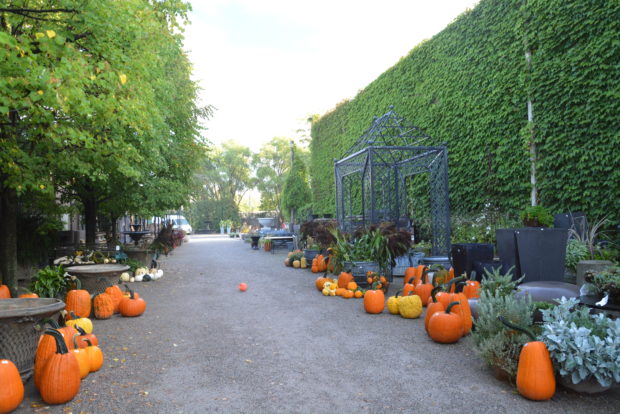 That leafy green wall is a delight. No one needs to squint, walking down the drive. Our driveway is garden like, no matter the season. This intermittent planting of Boston ivy vines in 2 gallon pots has produced a thriving green wall almost 100 feet long, and 20 feet high. There has never been any need for special care, feed, or supplementary irrigation. We do water when conditions are extremely dry, and when we think to water. Otherwise, we only take the time to enjoy the look. The science of how leaves change color is not totally understood, but my oversimplified version is as follows. Leaves have 3 major pigments integral to their structure. Chlorophyll, a primary pigment which gives leaves their green color, is necessary for photosynthesis. The production of food to sustain life is indeed primary. Photosynthesis is a chemical reaction between sunlight and chlorophyll, the upshot of which enables leaves to manufacture sugar. Sugar? Another word for food. The other pigments hidden by the green that chlorophyll dominates are red and yellow pigments.
That leafy green wall is a delight. No one needs to squint, walking down the drive. Our driveway is garden like, no matter the season. This intermittent planting of Boston ivy vines in 2 gallon pots has produced a thriving green wall almost 100 feet long, and 20 feet high. There has never been any need for special care, feed, or supplementary irrigation. We do water when conditions are extremely dry, and when we think to water. Otherwise, we only take the time to enjoy the look. The science of how leaves change color is not totally understood, but my oversimplified version is as follows. Leaves have 3 major pigments integral to their structure. Chlorophyll, a primary pigment which gives leaves their green color, is necessary for photosynthesis. The production of food to sustain life is indeed primary. Photosynthesis is a chemical reaction between sunlight and chlorophyll, the upshot of which enables leaves to manufacture sugar. Sugar? Another word for food. The other pigments hidden by the green that chlorophyll dominates are red and yellow pigments.
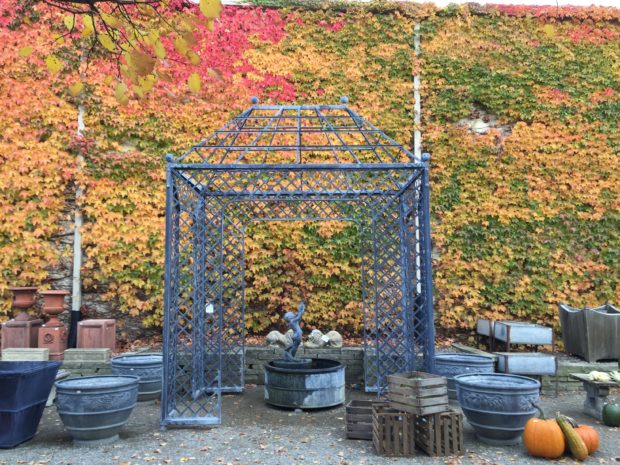 Every gardener is aware that our daylight hours are growing shorter. Leaves respond to a shorter day length by slowing their production of chlorophyll. This makes sense. The slowing of the production of chlorophyll is one of many mechanisms in plants triggered by the shortening days that directs them to slow down their growth before the end of the growing season. Once the production of chlorophyll wanes, the red and yellow pigments in leaves begin to show. Fall color. The temperature and rainfall may play a roll in the timing of fall color, but the most significant factor is day length.
Every gardener is aware that our daylight hours are growing shorter. Leaves respond to a shorter day length by slowing their production of chlorophyll. This makes sense. The slowing of the production of chlorophyll is one of many mechanisms in plants triggered by the shortening days that directs them to slow down their growth before the end of the growing season. Once the production of chlorophyll wanes, the red and yellow pigments in leaves begin to show. Fall color. The temperature and rainfall may play a roll in the timing of fall color, but the most significant factor is day length.
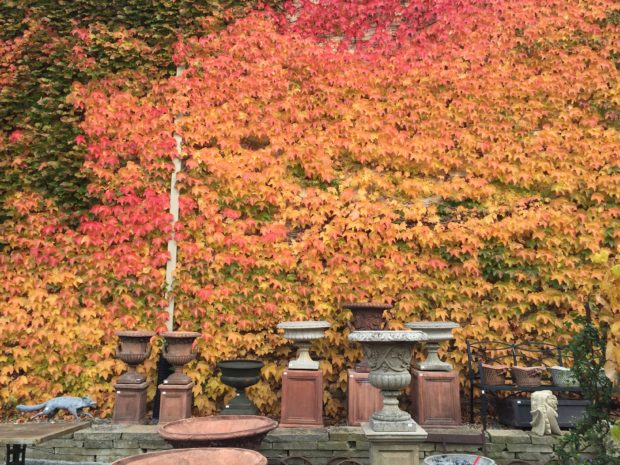 The popular hoopla about the dangers presented to masonry walls by Boston ivy is well documented. I am sure there are still those who suggest that a covering of Boston ivy will bring down a building. This has not been my experience. How this vine grips a vertical surface is serious. The vine sends out sucker discs, or gripping pads, which hold the branches of the vine close to the wall. Have I ever seen any damage to our walls in 20 years-no. Many universities in the eastern part of the US, popularly known as Ivy league schools, feature buildings dressed to the nines in Boston ivy. They have been that way a long time. Our green wall requires little in the way of care. But it provides a stunning backdrop for all we have going on at the shop in every season. Once the season turns from summer to fall, I can count on the Boston ivy to tell a spectacular fall story. Every year is different. Some areas turn red, and others are yellow. Some spots are a mix of red and peach and yellow. Some leaves stay green until they drop. Others are a fiery red. Every year, that tapestry of color created by these 10 vines is different. Every year, the fall color is breathtaking. I have yet to tire of it.
The popular hoopla about the dangers presented to masonry walls by Boston ivy is well documented. I am sure there are still those who suggest that a covering of Boston ivy will bring down a building. This has not been my experience. How this vine grips a vertical surface is serious. The vine sends out sucker discs, or gripping pads, which hold the branches of the vine close to the wall. Have I ever seen any damage to our walls in 20 years-no. Many universities in the eastern part of the US, popularly known as Ivy league schools, feature buildings dressed to the nines in Boston ivy. They have been that way a long time. Our green wall requires little in the way of care. But it provides a stunning backdrop for all we have going on at the shop in every season. Once the season turns from summer to fall, I can count on the Boston ivy to tell a spectacular fall story. Every year is different. Some areas turn red, and others are yellow. Some spots are a mix of red and peach and yellow. Some leaves stay green until they drop. Others are a fiery red. Every year, that tapestry of color created by these 10 vines is different. Every year, the fall color is breathtaking. I have yet to tire of it.
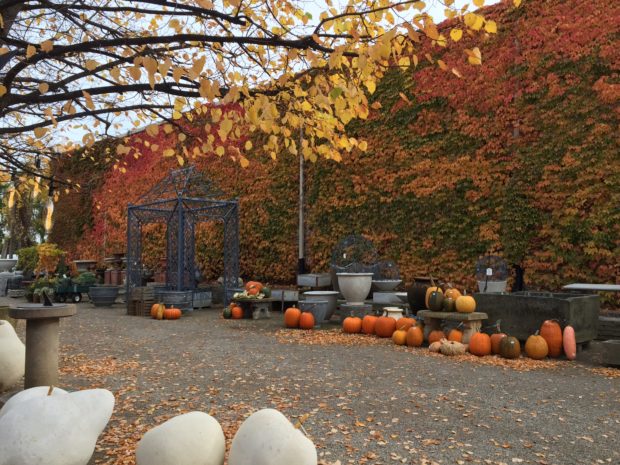 Boston ivy is a very vigorous and self supporting vine. It needs a lot of width, a lot of height, and a huge space to truly represent all that it can be. Who knew that 10 2 gallon pots of Boston ivy would look like this, 20 years later.
Boston ivy is a very vigorous and self supporting vine. It needs a lot of width, a lot of height, and a huge space to truly represent all that it can be. Who knew that 10 2 gallon pots of Boston ivy would look like this, 20 years later.
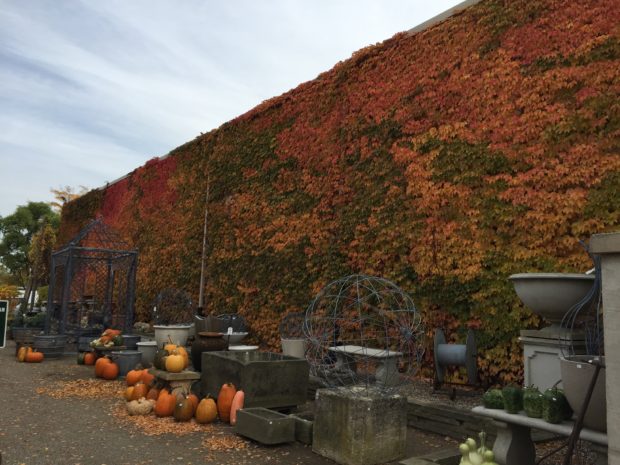 The next 10 days at Detroit Garden Works will feature this particular year’s tapestry of fall color on the Boston ivy. Stop by, should you have a mind to see the 2016 version. Too far away? I will post more pictures. The easy part is my picture taking. The miraculous part belongs to nature. Thank you, Madame Nature, for this moment.
The next 10 days at Detroit Garden Works will feature this particular year’s tapestry of fall color on the Boston ivy. Stop by, should you have a mind to see the 2016 version. Too far away? I will post more pictures. The easy part is my picture taking. The miraculous part belongs to nature. Thank you, Madame Nature, for this moment.
Love Boston Ivy and Virginia Creeper. Native Virginia Creeper however would have covered the wall in less than half the time and provided food in the form of berries for native birds.
The fall color of Viginia Creeper is much more vibrant than Boston Ivy.
Oh, YES, pictures, pictures please!! I blow against a neighborhood association, and a dead-set husband, but I would love my bare 3 story high stucco wall on the north side of our house just covered in this stuff! Many years ago when we had just one car and I drove my husband to work each day, I would sit in the car in rapture watching the ivy change color every fall on his office building. We have big trees. I have a mature schizophragma on an Oak. We have a mammoth beech tree that is in decline, but still hanging in there. Wonder if it is a candidate for a coat of ivy?
Great post! Thanks!
I think I will do a wall of Boston Ivy-
That is spectacular. . .no need to take a drive to look at all the different fall colors. . . they are all right there!
stunning deborah!
just returning from england where buildings from 600AD onwards are still standing, while ivy clad. those hardest to convince? midwestern husbands!
debra
Deborah, I will be sure to stop by this week. That wall is wonderful in all seasons in its own right and a beautiful neutral background for all that happens at its feet. My absolute favorite spot at DGW however, is the fountain wall inside the shop. So beautiful and calming.
The ivy is spectacular any color and, yes I have heard they destroy the wall too. I am glad to see here it does not.
Lovely. We had Boston Ivy growing on the entire side of our house in Detroit when I was growing up. That was 50 years ago and I remember how beautiful it was as if I were seeing it today. Thanks for the memory.
Where can I hit the “like” button? Such wonderful writing, such an engaging story about a wall of Boston ivy. I wish I lived closer – keep those photos coming. I can envision walking down the driveway with that wall of color. Thank you!
Opportunity knocked. What a perfect solution! It’s charming and is the perfect backdrop to your wonderful, creative pieces.
Susan in MT
Gorgeous
The smartest thing I have ever done is plant Boston Ivy on my houses. First, my house in Pasadena; a real treasure of a French Regency Pavilion copied from one outside Paris in the fifties. 18th century boiserie….and exquisite taste! (Unfortunately, the intervening owners sprayed the exterior with cottage cheese stucco!) It would have been so expensive to remove or skim over….so I planted Boston ivy. Gorgeous…..to this day! That was 32 years ago!!!
The house we built in Montecito 20 years ago….same thing! It is a gorgeous way to dress a house!
20 years later……we get fall…spring….and tracery in the winter in Santa Barbara!!! (we pretend we have seasons!)
And thank YOU, dear Deborah, for posting this visual feast for those of us too far away to visit in person. So lovely.
Warmly,
Kay
Love the Boston Ivy.
Looks stunning Deborah! Do you use the fallen leaves creatively?
Dear Clare, I am not sure I understand your question, but no, I do not do anything with the fallen leaves. best, Deborah
Deborah,
What a lyrical, delightful and intelligent description of your beautiful Boston Ivy wall! I remember when your ivy first began growing there. It is indeed a lovely background for the outside of your shop and your garden furniture, etc, and probably as well grown as – or better than – those Ivy League vines. I will definitely stop by to see your fall color. Thanks for the best description of Boston Ivy I’ve ever read.
It is such a treat to see your Boston Ivy wall covering. Thank you for sharing the details of color changes with that plant. Would the Boston Ivy work on a Arbor Trellis? I have tried a Climbing Rose, Evergreen Jasmine and now a very weak white Wisteria. The Arbor is behind a boxwood hedge next to the house and plant roots are in the shade with the rest of the climber getting plenty of sunshine.
Dear Linda, a nursery person or designer who can look at your arbor and growing situation in person is your best chance to get good help with this. best, Deborah
My husband and I attended your Garden Cruise this summer and that is when I saw your wall of Boston Ivy. We were enjoying a glass of wine and the music at a table outdoors facing the wall. There was a stiff breeze and the ivy was undulating in waves. I was mesmerized. Perhaps on a windy day you could post a video for all your readers to enjoy.
Oh! Yes please! 😀
Dear Alice, our Boston Ivy has been very slow to color up this year-maybe I will yet have a chance to video it on a windy day. all the best, Deborah
Beautiful! Just goes to show that every plant has the right space and every space needs the right plant.
Dear Alexandra, well said. thanks, Deborah
I’ve always heard to plant Boston Ivy instead of English Ivy because English will destroy the building, but Boston won’t. I was surprised to hear that some say that about Boston Ivy.
Although I see the appeal to use Virginia Creeper, in my experience it is a bit patchy and requires a bit more work to make a solid covering. (I tried posting a pic showing it, but can’t)
Boston has a lovely shingling aspect that VAcreeper just doesn’t live up to imo.
Great article! I always look forward to your updated pics of the building wall! what an awesome way to make an eyesore into an asset.
Dear April, I agree with you about the Virginia Creeper-it is patchy growing. As for the fruit-my Boston ivy fruits heavily-the birds get it all. I will never forget your description of the “shingling aspect” of the leaves-what a beautiful description! thank you, Deborah
I too love the red, orange, yellow fall color and the almost waxed green of the summer color. And the dried leaves in the fall clatter like poplar leaves. I had an office on the enclosed porch of an old tudor style home in Plymouth that faced the back of a motel covered in Boston ivy. The year round show was impressive; that ivy made the parking lot a courtyard.
Our home in drab brick in Ann Arbor was also covered in Boston ivy. Trimming it at the windows, gutters and garage became a hassle. And no it did nothing to the mortar. However, when it comes time to remove the vine, the vines come down leaving hairy connections to arrays of little dot sized feet, which look like little paw prints.
And to remove those paw prints requires letting them dry out and taking a scraper in hand and running it over each and every single one of those tiny little pads. On the brick you can be careless and on the mortar you have to use just enough force to scrape the dots and not chip the mortar.
And having done all that, I planted English ivy which pretty much minds its business as a ground cover and stays at the base of the barbecue and tries to invade the basement windows. I miss the Boston ivy, not so much the little paw prints and the interference at the screens. Boston ivy: there is no better cover for an ugly wall or house. And if someone else can trim it and or scrape the pads, then it is perfect.
Dear Mark, Making decisions about what plant to use in what place is a very important part of gardening. I have Baltic ivy at my house which is old enough to climb. It does have to be trimmed to keep it out of the eaves and off the windows. It is a nuisance, but I like it well enough to keep up with the trimming. Yes, those Boston ivy pads stick like crazy. So having a giant wall without any windows, and without any thought to ever tear it off figured prominently in the decision to plant it. all the best, Deborah
I suppose I am a ‘sucker’ to believe all of societies problems can be solved so beautifully–but I do believe that! What a stunningly delightful, not to mention beautiful, solution.
Dear Perri, thanks for your letter. Best, Deborah
Hi Deborah,
Do you have any photos of those 2 gal containers? I’m curious about how they have been irrigated/fertilized/maintained over the last 20 years. I have an ugly fence to hide along the North side of my property line, and it parallels about 50 feet of driveway. I’ve been considering something similar by attaching a metal trellis along the length (because the fence will be replaced by the neighbors soonish) with climbers in pots. Because the fence is south-facing (on my side) it will dry out, and stringing irrigation across is awkward, though doable. Have you ever root-pruned or replaced the soil in any of the containers with the ivy still attached? Just trying to think through the solutions before committing to one. Thanks in advance.
Dear Grace, I must not have been clear, sorry. The plants were 2 gallon pot size. We took the pots off, and planted them in the ground. It would not have been feasible to leave them in pots. best, Deborah
Thank you Deborah; I’ll see if I can try something that remains in pots and let you know!
Grace- did you try the Boston ivy in pots year round? I have a similar problem to yours – have to keep them in pots. I am in southern PA. I would even be able to put them in more substantial pots, say 2 separate 2 gallon plants in a planter box that is 3 feet deep, 4 ft wide, 3 ft height. So it would be a lot of dirt, but still, in a box in a patio.
Deborah- any thoughts on this?
Thank you!
Dear Michael, I would suggest you try it. Why not? Boston ivy is pretty rugged. best, Deborah
Can Boston ivy be left outside in planters or pots year round in central New Jersey with the same positive grow and life span of others planted in the ground?
Dear Keith, I think not, but check with a local nursery person. best, Deborah
I had already done that, they suggested asking someone (professional) like you for the answer. Thanks for nothing.
Dear Keith, I am a professional in a zone different than New Jersey. I would not expect Boston Ivy to be hardy in my zone in pots. But truth be told, I have never tried it. So I have no clear answer to offer-providing you lived near me. This is my best advice. If you are adventuresome over there in New Jersey, try it. Otherwise, find a really knowledgeable person at a full service nursery near you. It may take some time to find that person who is truly knowledgeable. Even they might not be able to make any guarantees. Nature bats last. That you can count on. If you got nothing from my advice, I would suggest the idea that growing plants is a big fluid situation is in fact something. Some things work, and others don’t. best regards, Deborah
No it can’t as it will firstly not develop the root structure and spread required in a pot for it to become the plant you intended it to look like. Secondly without proper protection from the winter by being in the ground it will likely suffer some damaged roots every year even if it does come back it will loom poorly as a result. Thirdly the root damage can lead to root rot killing the plant. But if you want to try it go ahead, most nurseries warranty them. But don’t be a jerk. “Thanks for nothing”, that is not necessary.
I have had Boston Ivy planted for four years, and it has really taken off. My problem is that it is not turning the brilliant colors for which I hoped. It stays green until it loses its leaves in early winter. Do you know the cause?
Dear Greg, I do not know. Have you looked it up on line? best, Deborah
Hi Debra, I know this is an older blog post, but we’re looking at Boston Ivy, we’re in Melbourne and a typical winter day might be around 50oFwith a low down to 40oF, maybe on occassion?
Anyway, we have a concrete driveway that runs up to and along the house that we’d like to plant the Boston Ivy. My preference would be to not cut and pull up the concrete because i’m not sure we’ll get a nice finish, instead I thought we could build a long planter box.
My question is how deep does the root system grow to help give me a steer in terms of how big/deep the planter box needs to be? I’m expecting the planter to be about 12′ long.
Thanks in advance.
Cheers,
Chris
Dear Chris, I am not the right person to ask about this-ask someone local to you who knows your conditions both summer and winter. I have seen concrete saw cut with a wet saw that looks pretty finished. Good luck to you! best, Deborah
Deborah you are awful at engaging with your followers. You don’t even try to find the answers. What’s the point in posting if you can’t even provide gardening advice. I hate that Pinterest redirected me to your rude site.
Dear Erica, this blog is not a gardening Q and A column written by a journalist with a specialty in garden whose job is to answer questions written in by readers. That I am not that person does not make me rude. I am a professional landscape designer who works full time. I have written 1787 essays on my views and observations of gardening over the past 14 years. This is what I have to offer. People can take from those essays what they will, or not. best regards, Deborah